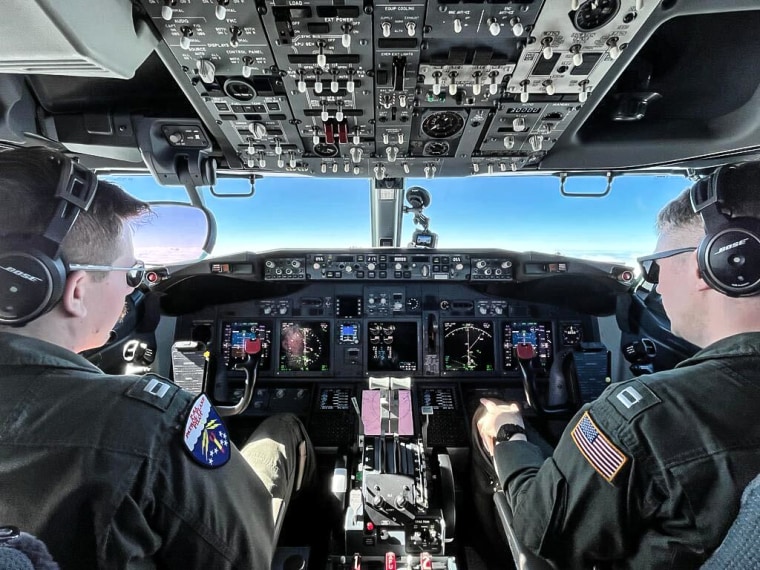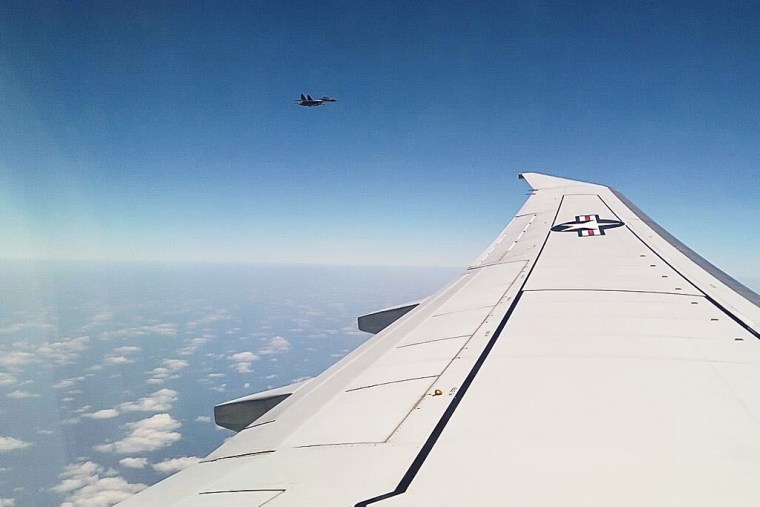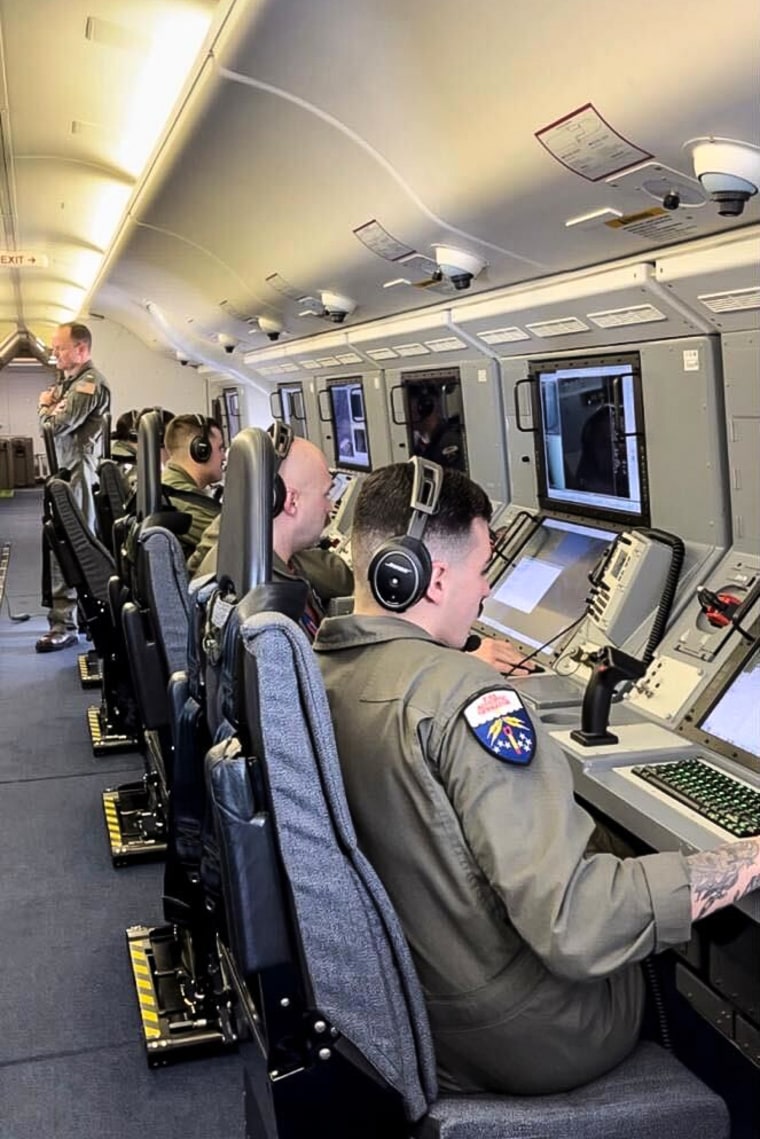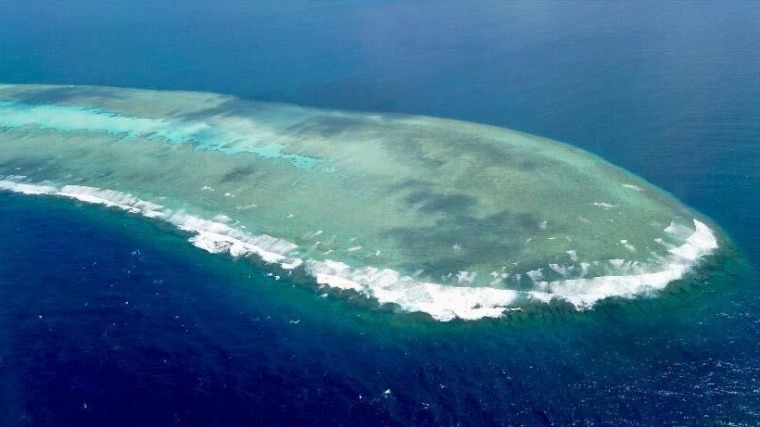ABOARD A U.S. PATROL AIRCRAFT — The U.S. Navy plane had been in the air over the South China Sea for a few hours when a warning came crackling over the radio.
“No approaching any more or you will pay full responsibility,” said a voice from a ground station belonging to China’s air force.
Soon after, a Chinese J-11 fighter jet appeared about 500 feet off the left wing, flying beside the American P-8 Poseidon maritime patrol aircraft for well over an hour as it passed over mostly uninhabited islands that are claimed by both China and its neighbors.

U.S. officials said encounters like the one witnessed by NBC News on Friday, though professional, are becoming more frequent as Beijing and Washington step up their campaigns for influence in the Pacific. The strategically important South China Sea is an increasingly prominent stage for the spiraling tensions between the world’s two largest economies, which have clashed over everything from Taiwan to the war in Ukraine.
Inside the plane, U.S. Navy officers sat at about half-dozen computer stations, analyzing radar images from powerful specialized cameras affixed to the outside of the aircraft as it made way around the Paracel Islands across the South China Sea, before returning to Kadena Air Base in Okinawa, Japan.
Once a Chinese plane comes within 1,000 feet “we’ll communicate with them,” Capt. Will Toraason, the commander of U.S. Navy surveillance aircraft, told NBC News early Friday.
“Typically we don’t get a response, sometimes we’ll get nonverbal responses. But overall we’re trying to encourage a safe and professional encounter while we’re both operating in international airspace,” he said.

China, which has the world’s largest navy, claims sovereignty over most of the South China Sea despite a landmark 2016 ruling by an international tribunal that its claims have no legal basis. Its stance has antagonized a number of countries in the region with which it has territorial disputes.
The U.S. and many of China’s neighbors accuse Beijing of using “gray zone” tactics that are not legally acts of war to intimidate other countries and assert greater control over the area. In response, the U.S. regularly conducts “freedom of navigation” and other operations in international waters and airspace.
China says it is protecting its sovereignty and maritime interests and that “close-in reconnaissance” by American planes and warships threatens its national security and undermines regional peace and stability.
Artificial islands that China has built in the last decade have made it easier for its coast guard and maritime militia to carry out near-daily patrols. “You now see regularly a constant presence in the most contested areas,” said Raymond Powell of the Gordian Knot Center for National Security Innovation at Stanford.
On other islands that were once tiny, rocky outcrops, China has quietly installed runways, radar sites and missile systems.
“Since I’ve been in the Navy, going on 18, 19 years now, I can tell you there is a dramatic change over that span, specifically the South China Sea,” said Cmdr. Marc Hines on board the U.S. aircraft. He added that the buildup of runways and hangars is “typical now but it wasn’t necessarily the case” when he joined the Navy.

The result is some tense encounters. Late last year, the U.S. military said an Air Force aircraft conducting routine operations over the South China Sea was forced to take evasive maneuvers to avoid colliding with a Chinese fighter jet that was flying dangerously close. Beijing blamed the U.S. and said it would continue to take “necessary measures.”
Given U.S.-China tensions over issues including China’s surveillance balloon program, the concern is that a minor incident in the South China Sea could easily escalate, said John Rennie Short, a professor at the University of Maryland, Baltimore County, who studies the geopolitics of the region.
“You just worry that a small spark could burst into flame,” said Short, who is spending the semester at the University of the Philippines Diliman in Manila.
Worried about Chinese incursions, the Philippines under President Ferdinand Marcos Jr. is reinvigorating its relationship with the U.S., which is looking to re-engage with the Asia-Pacific region not just militarily but economically and diplomatically as well.
During a visit by Defense Secretary Lloyd Austin this month, the two countries announced a deal expanding U.S. access to military bases there. They also agreed to resume joint maritime patrols in the South China Sea.
Hu Bo, director of the South China Sea Strategic Situation Probing Initiative at Peking University in Beijing, said China has the right to follow and monitor U.S. military activity in the South China Sea from a security point of view.
“The United States would not be happy as well if the Chinese military maintained a large military presence around the United States,” he said, adding that China’s position on the South China Sea had been consistent and it was countries like the Philippines that were being more aggressive.
“To the outside world it seems that China’s policy is aggressive, but from the Chinese perspective, China has actually been very restrained and has not made any new moves,” he said. “On the contrary, other parties have made more moves.”
“If other countries take relevant measures,” he added, “China will have to counteract.”
Experts say the Philippines has been much more transparent about its issues in the South China Sea under Marcos, who is less friendly to China than his predecessor, Rodrigo Duterte.
The Philippines has also been reaching out to other allies in the region, like Japan and Australia, the latter of which is also considering joint maritime patrols.
“They’re working very hard to internationalize this concern, which I think works in their favor,” Powell said.

In the meantime, China is outpacing the U.S. in building warships, Secretary of the Navy Carlos Del Toro said this week, with about 340 ships now and a goal of 440 by 2030. In comparison, the U.S. Navy had about 293 ships as of early 2020, according to a Defense Department report.
“They’ve got a larger fleet now so they’re deploying that fleet globally,” Del Toro said Wednesday at the National Press Club in Washington, adding that the U.S. Navy needs to increase capacity in response.
Powell agreed that both the U.S. and its allies would need to upgrade their fleets in order to compete with China, whose major advantage in the South China Sea, he said, is its ability to “flood the zone” with its security vessels.
“At some point, the number of ships actually does matter,” he said. “You can’t have a presence without ships.”
But the U.S. also has an advantage, Powell said, which is that it is not acting alone.
“China, when it looks out and sees ships, has to think about the U.S. plus its partners and allies,” he said, “whereas China doesn’t really have partners and allies.”
CORRECTION (Feb. 24, 2023, 7:17 p.m. ET): A previous version of this article misspelled the U.S. commander’s first name. He is Marc Hines, not Mark.
